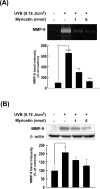Myricetin suppresses UVB-induced wrinkle formation and MMP-9 expression by inhibiting Raf
- PMID: 20093107
- PMCID: PMC2864126
- DOI: 10.1016/j.bcp.2010.01.004
Myricetin suppresses UVB-induced wrinkle formation and MMP-9 expression by inhibiting Raf
Abstract
Chronic exposure to solar ultraviolet (UV) light causes skin photoaging. Many studies have shown that naturally occurring phytochemicals have anti-photoaging effects, but their direct target molecule(s) and mechanism(s) remain unclear. We found that myricetin, a major flavonoid in berries and red wine, inhibited wrinkle formation in mouse skin induced by chronic UVB irradiation (0.18J/cm(2), 3 days/week for 15 weeks). Myricetin treatment reduced UVB-induced epidermal thickening of mouse skin and also suppressed UVB-induced matrix metalloproteinase-9 (MMP-9) protein expression and enzyme activity. Myricetin appeared to exert its anti-aging effects by suppressing UVB-induced Raf kinase activity and subsequent attenuation of UVB-induced phosphorylation of MEK and ERK in mouse skin. In vitro and in vivo pull-down assays revealed that myricetin bound with Raf in an ATP-noncompetitive manner. Overall, these results indicate that myricetin exerts potent anti-photoaging activity by regulating MMP-9 expression through the suppression of Raf kinase activity.
2010 Elsevier Inc. All rights reserved.
Figures






Similar articles
-
Naringenin targets ERK2 and suppresses UVB-induced photoaging.J Cell Mol Med. 2016 May;20(5):909-19. doi: 10.1111/jcmm.12780. Epub 2016 Feb 10. J Cell Mol Med. 2016. PMID: 26861188 Free PMC article.
-
Inhibition of UVB-induced wrinkle formation and MMP-9 expression by mangiferin isolated from Anemarrhena asphodeloides.Eur J Pharmacol. 2012 Aug 15;689(1-3):38-44. doi: 10.1016/j.ejphar.2012.05.050. Epub 2012 Jun 7. Eur J Pharmacol. 2012. PMID: 22683868
-
The flavonoid hesperidin exerts anti-photoaging effect by downregulating matrix metalloproteinase (MMP)-9 expression via mitogen activated protein kinase (MAPK)-dependent signaling pathways.BMC Complement Altern Med. 2018 Jan 30;18(1):39. doi: 10.1186/s12906-017-2058-8. BMC Complement Altern Med. 2018. PMID: 29382339 Free PMC article.
-
Myricetin inhibits UVB-induced angiogenesis by regulating PI-3 kinase in vivo.Carcinogenesis. 2010 May;31(5):911-7. doi: 10.1093/carcin/bgp221. Epub 2009 Dec 11. Carcinogenesis. 2010. PMID: 20008033 Free PMC article.
-
Alpinia officinarum Rhizome ameliorates the UVB induced photoaging through attenuating the phosphorylation of AKT and ERK.BMC Complement Med Ther. 2022 Sep 2;22(1):232. doi: 10.1186/s12906-022-03707-w. BMC Complement Med Ther. 2022. PMID: 36123596 Free PMC article.
Cited by
-
Topically applied Hsp90 inhibitor 17AAG inhibits UVR-induced cutaneous squamous cell carcinomas.J Invest Dermatol. 2015 Apr;135(4):1098-1107. doi: 10.1038/jid.2014.460. Epub 2014 Oct 22. J Invest Dermatol. 2015. PMID: 25337691 Free PMC article.
-
Naringenin targets ERK2 and suppresses UVB-induced photoaging.J Cell Mol Med. 2016 May;20(5):909-19. doi: 10.1111/jcmm.12780. Epub 2016 Feb 10. J Cell Mol Med. 2016. PMID: 26861188 Free PMC article.
-
Insights into dietary flavonoids as molecular templates for the design of anti-platelet drugs.Cardiovasc Res. 2013 Jan 1;97(1):13-22. doi: 10.1093/cvr/cvs304. Epub 2012 Sep 27. Cardiovasc Res. 2013. PMID: 23024269 Free PMC article. Review.
-
Selected Cytokines and Metalloproteinases in Inflammatory Bowel Disease.Int J Mol Sci. 2023 Dec 22;25(1):202. doi: 10.3390/ijms25010202. Int J Mol Sci. 2023. PMID: 38203373 Free PMC article. Review.
-
Role of Matrix Metalloproteinases in Photoaging and Photocarcinogenesis.Int J Mol Sci. 2016 Jun 2;17(6):868. doi: 10.3390/ijms17060868. Int J Mol Sci. 2016. PMID: 27271600 Free PMC article. Review.
References
-
- Sams WM, Jr., Smith JG., Jr. The histochemistry of chronically sun-damaged skin. An investigation of mucopolysaccharides and basophilia in actinically damaged skin using alcian blue, mowry's, and Hicks-Matthaei stains, methylation, and saponification. J Invest Dermatol. 1961;37:447–53. - PubMed
-
- Smith JG, Jr., Davidson EA, Sams WM, Jr., Clark RD. Alterations in human dermal connective tissue with age and chronic sun damage. J Invest Dermatol. 1962;39:347–50. - PubMed
-
- Gilchrest BA. A review of skin ageing and its medical therapy. Br J Dermatol. 1996;135:867–75. - PubMed
-
- Grewe M, Trefzer U, Ballhorn A, Gyufko K, Henninger H, Krutmann J. Analysis of the mechanism of ultraviolet (UV) B radiation-induced prostaglandin E2 synthesis by human epidermoid carcinoma cells. J Invest Dermatol. 1993;101:528–31. - PubMed
-
- Chung JH, Seo JY, Choi HR, Lee MK, Youn CS, Rhie G, et al. Modulation of skin collagen metabolism in aged and photoaged human skin in vivo. J Invest Dermatol. 2001;117:1218–24. - PubMed
Publication types
MeSH terms
Substances
Grants and funding
LinkOut - more resources
Full Text Sources
Other Literature Sources
Medical
Research Materials
Miscellaneous

